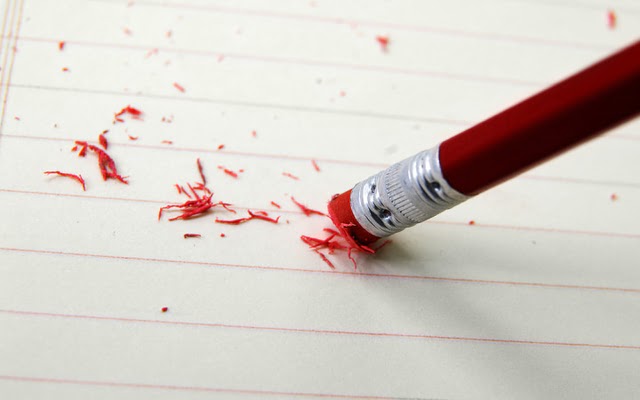
2 + 2 = 5. Oops! Not quite… now where did I put that eraser?
Mistakes occur frequently. And that’s acceptable. Everyone makes mistakes. The crucial thing is to gain knowledge from them… and eliminate them as soon as you notice them!
Have you ever pondered over how that small pink piece of rubber at the end of your pencil is capable of removing what you’ve written? Is it magic? No! There’s a completely logical, scientific explanation.
However, before we delve into how erasers work, let’s acquire some knowledge about what exactly is on the paper that you’re erasing. Although we refer to the black substance in pencils as “lead,” it is not the actual metal known as lead.
It is actually a mineral called “graphite,” which consists of carbon. When you write with a pencil, graphite particles from the pencil rub off and adhere to the fibers of the paper you’re writing on.
While pencils are filled with graphite, erasers are primarily made of rubber, although plastic and vinyl are occasionally used. The rubber is usually mixed with sulfur to increase its durability.
A softening agent, such as vegetable oil, is also typically added to make the eraser more flexible. Lastly, abrasives, such as pumice or quartzite, are incorporated, along with dye to give the eraser a specific color.
When you rub an eraser across a pencil mark, the abrasives in the eraser gently scrape the surface fibers of the paper to loosen the graphite particles. The softeners in the eraser help prevent the paper from tearing. The adhesive rubber in the eraser grasps and retains the graphite particles.
Erasers function due to friction. Try rubbing your hands together right now. Do you feel them getting warmer the longer you rub? The warmth you feel is the heat generated by the force of friction created by the rough surfaces of your hands rubbing together.
As the abrasives in your eraser are rubbed against paper, friction produces heat, which helps the rubber become sticky enough to hold onto the graphite particles. As the rubber grasps the graphite particles, small pieces of combined rubber and graphite are left behind. That’s the residue you brush off your paper when you’re finished erasing.
An English engineer named Edward Naime invented the eraser in 1770. Prior to that time, people typically used rolled-up pieces of white bread to erase pencil marks.
Legend has it that Naime accidentally grabbed a piece of rubber instead of bread and discovered that it could “rub” out pencil marks. That’s where the term “rubber” comes from.
Try It Out
Ready to eliminate mistakes? Explore the following activities with a friend or family member.
- Erasers have the ability to correct mistakes, but they can also be utilized for creating various interesting crafts. Check out the following art projects and choose one or more to experiment with: Carve a stamp using a pencil | Make eraser earrings.
- There are several types of erasers available, but which one is the most effective? Visit Education.com and explore the Eraser Test. Conduct the experiment with the assistance of a friend or family member, gather your data, and then write about the findings.
- Have you ever wished to make an entire message disappear? You can achieve this with homemade invisible ink from George Washington’s Mount Vernon. Make sure you have all the necessary supplies and then follow the instructions to write a secret message for a friend or family member to decipher!
FAQ
1. How does an eraser work?
An eraser works by using a combination of friction and absorption to remove pencil marks from paper. When you use an eraser, the friction between the eraser and the paper causes the pencil marks to be lifted off the surface. The eraser itself is made of a soft and flexible material, usually rubber or vinyl, which helps to dislodge the pencil marks without damaging the paper. Additionally, erasers often contain small particles or fibers that help to absorb the graphite from the pencil marks, further aiding in their removal.
2. What happens when you erase something?
When you erase something, the eraser rubs against the paper, creating friction. This friction causes the graphite particles from the pencil marks to adhere to the eraser, effectively removing them from the paper. As you continue to erase, the graphite particles accumulate on the eraser, which is why you may need to clean or replace the eraser after repeated use. The friction also helps to break up and disperse the graphite particles, making them less visible on the paper.
3. Can erasers remove pen ink?
No, erasers are not effective at removing pen ink. Erasers are specifically designed to remove pencil marks, which are made of graphite. Pen ink, on the other hand, is made up of pigments or dyes that are dissolved in a liquid solvent. The chemical composition of pen ink is different from that of graphite, so erasers are not able to effectively remove it. If you need to remove pen ink, it is best to use a specialized ink remover or consult professional cleaning methods depending on the surface and type of ink.
4. Are there different types of erasers?
Yes, there are different types of erasers available. The most common type is the pink or white eraser, which is made of rubber or vinyl. These erasers are soft and gentle on paper, making them suitable for most erasing needs. There are also kneaded erasers, which are moldable and can be shaped to a point for more precise erasing. Kneaded erasers are often used by artists. Additionally, there are electric erasers that use motorized rotations to erase pencil marks quickly and efficiently. Each type of eraser has its own advantages and is designed for specific purposes.





Leave a Reply